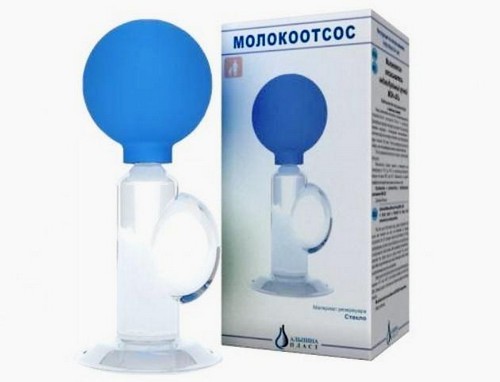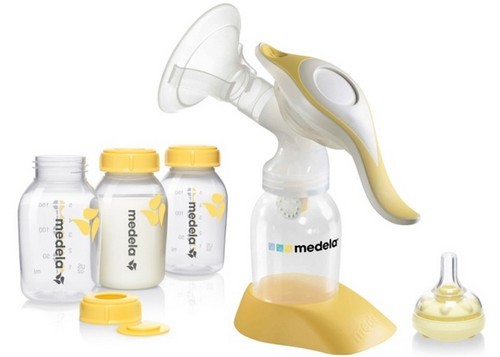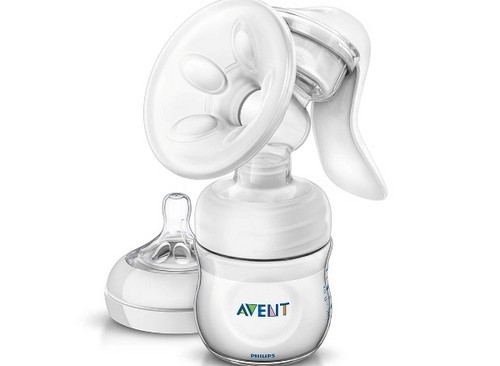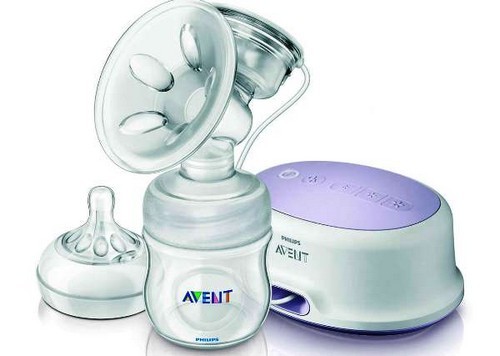The appearance of the baby brings a lot of joy, but also a lot of emotions. Due to stress and adaptation to changes in the composition of the family, lactation in a young mother at first may be unstable.
In such a situation, a manual breast pump is simply irreplaceable.
With it, you can prevent lactostasis, stimulate lactation, make a small supply of breast milk for the baby in an emergency. How does a manual breast pump work, what are its pros, cons and features? Let’s find out.
How does a manual breast pump work?
Usually it is a device with a vacuum nozzle and a reservoir for collecting milk. There are two types of manual breast pumps – proshnevy and pump-action. In the first case, the device is driven by a handle, and in the second by a special rubber bulb.
When you click on them, after applying the nozzle to the chest, the air from the breast pump is removed, as a result of which pressure is created inside the device. Under its influence, milk is pumped out and enters the collection tank.
Difference from electric
The main difference between a manual (mechanical) and an electric breast pump is that the first works from the touch of a hand, and the second from a battery or mains. Mechanical devices can not so accurately simulate the baby’s sucking movements, as electronic counterparts do, and require effort, but they are inexpensive. The price of the most budgetary of them starts from 150 rubles.
But you need to consider that manual breast pumps are less productive. They are recommended for women who need decantation not constantly, but from time to time.
Another difference – manual breast pumps allow expressing breasts only in turn. Electrical appliances can do this at the same time, if the configuration of the model allows. Naturally, the time for decantation is significantly reduced.

Advantages and disadvantages
Manual breast pumps are in demand among mothers.
This is due to the following positive qualities of the devices:
- affordable price;
- silent work;
- the ability to use away from power sources;
- simple sterilization and washing.
Of course, there are also disadvantages – the slow decanting process and its complexity, the risk of breakage of the handle of the device. Some mothers report discomfort and cracks in the nipples as a result of using a manual breast pump.
How to choose a model
If you want to try this method of pumping, the question arises which manual breast pump to choose. Of the two possible options – pump or piston, it is better to give preference to the second. It costs a little more, but treats the breast more carefully and effectively eliminates milk stagnation. In this category of breast pumps, you can find two-phase models that are as close as possible to the natural process of breast sucking by an infant.
You also need to pay attention to the nozzle. Optimally, if it is silicone, with a relief in the form of petals or bulges, which makes the pumping process more comfortable.
As practice shows, the presence of the selected breast pump reservoir-bottle and nipples for feeding is an additional plus. With it, you can feed the baby without transferring milk to another container. It is convenient if the kit contains containers for storing milk.
An overview of the best manual breast pumps
The release of manual breast pumps is handled by many manufacturers of baby products and medical equipment. We will briefly review the most popular models.
Philips AVENT

Phillips Avent manual breast pump is made in England. Its features are a silicone nozzle with five massage petals, located at a convenient angle to the chest, and the absence of a harmful substance in the composition of the material – bisphenol-A. The kit includes a bottle (it’s a reservoir), an anatomically shaped nipple, a nipple cap, a cap for the nozzle, containers for storing milk, 4 breast pads and detailed instructions.
Using this device can be done in 10 minutes. According to the reviews of mothers, you need to get used to using the Phillips Avent manual breast pump, at first there may be difficulties associated with loose fitting the nozzle. The durability of the device is not satisfactory.
All parts are easy to clean (dishwasher safe) and sterilized. The average price is 3,500 rubles.
Medela Harmony

This is a lightweight, compact and efficient Swiss-made manual breast pump. The material of the device does not contain bisphenol-A. The set includes: a bottle for collecting milk with a lid, a nozzle, a stable stand, a rotary handle.
Thanks to the last point, the breast pump can operate in a two-phase mode, accurately simulating the baby’s sucking movements. To use this function, you need to stimulate the chest by pressing the short side of the handle for a minute, and then proceed to expressing using the long side.
The Medela Harmony breast pump is easy to disassemble. All its parts can be washed and sterilized.
The disadvantages of the device include the lack of nipples for feeding and additional containers for storing milk. Also, mothers mention that the standard nozzle of the breast pump is not very convenient.
The diameter of the funnel included in the kit may be too large or small, which causes pain during pumping. You can solve the problem by purchasing a set of PersonalFit funnels of different sizes at the pharmacy. The average price of a breast pump is 2,000 rubles, the cost of additional nozzles is about 550 rubles.
Tommee Tippee Сloser to Nature

Tommee Tippee Closer to Nature manual breast pumps are made in the UK. In the composition of the material from which they are made, bisphenol-A is absent. As standard, the device is equipped with: a bottle for collecting milk (150 ml) with a lid, an anatomically shaped nipple, a soft massage funnel made of silicone, a handle, bra inserts (6 pcs.), And a container for microwave sterilization.
The Tommee Tippee Breast Pump is easy to disassemble. For sterilization, it is enough to put the parts into the attached container, pour 100 ml of water into it and put in the microwave for 3 minutes.
Moms who have used this breast pump report that the funnel may not fit snugly against the breast, resulting in poor pumping performance. It is also possible to leak milk from it during operation of the device. The average cost of a Tommee Tippee breast pump is 2,000 rubles.
Chicco Breast Pump Pump

Chicco’s Italian pump-action breast pump is compact and easy to use. It consists of the following parts: a funnel, a hand pump bulb, a connecting tube, a milk bottle (150 ml) with a pacifier and a lid, and a support base. Detailed instructions are also included with the product.
The device is easy to wash, plastic tolerates boiling well, does not have a foreign smell. But, like all pump-action models, this breast pump is not without flaws.
The first and main of them is low efficiency. The process of emptying the chest can take up to 30-40 minutes, while the hands noticeably get tired from working with the pump pear. Therefore, Chicco Pumps are not recommended for women who need regular pumping and have problems with lactation.
Among the other shortcomings, mothers note the instability of the bottle stand and the weak connection of the tube to the body. The price of the product is affordable – about 800 rubles.
“The world of childhood”

The manual pump “World of Childhood” is an inexpensive version of a piston device. Country of origin – China. The kit includes: a funnel with a silicone lining and a lid, a handle, 2 milk bottles, a stand and a lid for the bottle. A pacifier for feeding a baby needs to be purchased separately.
According to reviews, the breast pump is convenient to use, but with frequent use it quickly fails. Extraneous noise is possible when pressing the handle and pain in the nipples after using the device. The efficiency of pumping is average.
The World of Childhood breast pump is difficult to wash and cannot be sterilized (plastic is damaged), which is a significant drawback. The bottle is not airtight, so during pumping it must be kept strictly horizontally. The average price of a device is 1,650 rubles.
Breast pump – a thing necessary for every nursing mother. Mechanical models do their job well, but you should not save on them. It is better to buy a quality breast pump once and be sure of its reliability and safety.
Breast pumps – devices that simplify the expression of breast milk. They greatly facilitate the lives of mothers and are useful even to those whose children are breastfed. Among many such products, the Avent breast pump from the Philips brand stands out.

How is this device different from other similar ones? What are Avent breast pumps and how to use them? Let’s figure it out.
Why do I need a breast pump
If a woman does not plan to feed the baby from the bottle, it would seem, why does she need a breast pump? But even with breastfeeding, situations arise when pumping is necessary.
These include:
- Maternal disease incompatible with breastfeeding. Using a breast pump during treatment will help maintain lactation and avoid stagnation of milk.
- Lactation crisis. This condition, characterized by a decrease in milk production, can occur in every mother. If before the end of the feeding period is still far, lactation can be strengthened by frequent application of the baby to the chest or by using a breast pump.
- Elimination and prevention of lactostasis. If the baby does not cope with the volume of milk, the breast pump allows you to qualitatively empty the breast.
Avent Breast Pump Features
The Avent milk pump is equipped with a special massage nozzle for pumping, a milk bottle (125 ml) with a lid, a soft silicone nipple of a physiological form, a lid for transporting the device. The case of the product, depending on the model, is equipped with a handle or an electronic control unit with a power regulator. Also included are 4 bra inserts.
For the breast pump, you can purchase additional accessories – packages and containers for storing milk. The details of the device do not contain a dangerous carcinogen – bisphenol A. Therefore, the milk passing through it does not contain harmful impurities and can be safely used to feed the baby.
Views
Philips produces the following types of Avent breast pumps – manual (mechanical) and electronic, powered by mains or batteries. The devices of the first type operate by the principle of a syringe – for expressing a woman needs to press the handle at the top of the device. Intensity of work is regulated independently. Avent mechanical breast pump accurately imitates the sucking of a baby, and its affordable price and ease of use make it one of the most popular.
The second type of device fully automates the process of decantation. Mom just needs to position the nozzle on her chest and turn on the device.
Avent electronic breast pump is two-phase. This means that in his work there are two stages – first he makes short and frequent suction movements, and after that – longer and rarer. This is how the baby sucks milk.
There are also 3 power levels that allow you to adjust the breast pump to your needs. An electronic device costs 3-4 times more expensive than a mechanical one.
Operational Features
The Avent breast pump has usage features that distinguish it from other similar devices. The most important of them is a massage nozzle with five petals, installed at such an angle that it was convenient for a woman to express herself while sitting, without leaning forward.
Thanks to this, the procedure will be comfortable, even if my mother recently underwent a cesarean section. In addition, when decantation occurs in a position that promotes relaxation, its effectiveness increases.
Another feature is the compact size and low weight of mechanical and electronic devices that facilitate transportation. For a mom who uses the Avent breast pump, a pleasant surprise will be the simplicity of its assembly and the ability to wash all parts of the device (except the power supply) in the dishwasher.
Combining breastfeeding and bottle feeding becomes easier thanks to a wide silicone nozzle that accurately imitates the shape of a woman’s nipple. Also, the Avent breast pump nipple is easily cleaned of milk residues and has a special anti-colic valve.
How to use the Avent breast pump
There are differences in the operation of a mechanical and electronic device. Consider how to use the Avent breast pump, depending on its type.
Manual model

After purchase, the Avent manual breast pump should be disassembled and sterilized all its parts by putting them in boiling water for 5 minutes or using a sterilizer. Then the parts are removed, allowed to cool and with clean hands they are assembling the device. All parts must be joined without the use of force.
Instructions for expressing milk using the Avent mechanical breast pump:
- Wash your hands and chest with soap. Squeeze the nipple with your fingers to check the patency of the ducts. If drops of milk appear, pumping can begin.
- Take a comfortable position and firmly press the petal nozzle of the breast pump to the chest. Between her and the skin should not penetrate air.
- Press the appliance handle 5-6 times at a fast pace to stimulate milk flow.
- Start pumping by pressing the handle and holding it for 2-3 seconds each time.
- If milk is not excreted within 5 minutes, check the correct assembly of the device and the tightness of the nozzle to the chest.
- The process should not cause pain. If you feel uncomfortable, you should reduce the intensity of movements, not squeezing the handle of the device to the end. If pain persists for a long time, despite the measures taken, pumping out of the breast pump must be stopped and consult a doctor.
- During the procedure, make sure that milk does not overfill the collection bottle. If a single 125 ml volume is not enough, use a larger container (sold separately).
- After use, the device should be disassembled and washed in soapy water. It is not necessary to use powdered and antibacterial agents.
Electric model
The Avent electric breast pump is as easy to operate as mechanical. To express with its help, sterilize the parts of the device that come into contact with milk and carry out the preparatory steps from point 1 of the above instruction.

Avent Electric Breast Pump Operating Rules:
- Sit in a comfortable chair, press the nozzle of the assembled device to the chest so that the nipple is located strictly in the center.
- Turn on the device by pressing the power button. The operation of the breast pump will begin with a stimulation mode, while you feel a “suction”.
- When milk begins to flow into the tank, select the appropriate decantation mode. There are 3 of them – from delicate to intense. The first mode is indicated by one drop, the second by two, the third by three. You can change the intensity by pressing the corresponding button at any time of the procedure. You do not need to use all the modes in turn, choose any one that is comfortable for you.
- After decantation, the device is turned off and only then, with a careful movement, remove the nozzle from the chest.
- Upon completion of the operation of the breast pump, the milk bottle is unscrewed. It can be poured into another container or stored in the refrigerator by closing the lid that comes with the kit.
- Parts of the breast pump in contact with milk should be washed in soapy water.
- If the device is powered from the mains, the cord is removed from the outlet, carefully wrapped around the motor and put away for storage.
Situations may occur when pumping does not start for more than 5 minutes. Provided that the device is in good condition, correctly assembled and applied, this may indicate a small amount of milk in the chest. In this case, decantation should be postponed. Sometimes a warm rush helps to cause a rush of milk.
Most of the mothers who used the Avent breast pump find it very convenient, noting the simplicity of caring for the device, the comfort of the nozzle and the effectiveness. What do you think of him? Share your experience with Avent breast pump in the comments.



